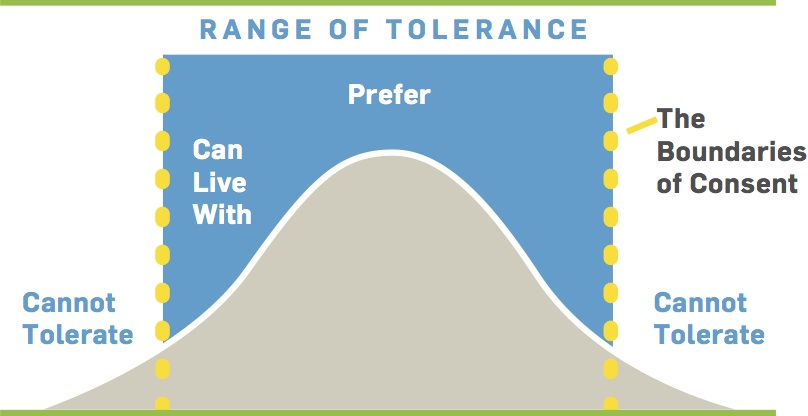Consent and consensus are different.
Difference #1: Consent has a precise definition.
Consent has a precise definition. There are many opinions about what consensus is. As we talk about differences, you may find yourself thinking, “But that’s not how I do consensus.” We are speaking now in general terms from our experience of different groups and from the assumptions people often make about consensus.

Life is full of risks and complexity. We often have to make decisions and move forward without complete certainty. In circle meetings, participants may identify potential risks with proposals. These might involve conflicts with the organization’s purpose and strategies or the creation of conditions that would make it very difficult for a member to perform his or her role.
Using the Principle of Consent, members don’t “block” decisions. If they cannot accept the proposed action, they state their objections with reasons that can be understood by other members of the circle. The role of the circle is to listen with the intent to understand those reasons and to adapt the proposal to minimize the risks. Members do not waste time debating or trying to persuade other members to minimize their objections.
Consent means there are no significant objections to a policy. Consent does not require agreement, affirmation or even preference. Consent is reached when no one is aware of a risk that we can’t afford to take.
Life is full of paradoxes, diversity, and “both/and” situations. Instead of needing everyone to agree on the perfect solution for the foreseeable future (which is pretty unrealistic when you think about it), consent allows the organization to find a “good enough” solution to move forward, knowing they will learn and adjust as they go.
Sometimes, just proposing to try something for a specific period of time reduces the risks and produces consent. The Consent process harnesses the collective wisdom of the group, adapting and innovating until proposals have the buy-in of those responsible for or affected by the decisions. Consent is different from compromise, which is a process of making concessions.
Difference #2: Only certain decisions are made by Consent.
So much efficiency is lost when people believe they always need to make decisions together. Instead, we recommend having consent as the basis for decisions in special circle meetings for governance decisions.

We consent on governance decisions, and empower individuals to make day-to-day, operational decisions with a level of autonomy to get the job done. A group might designate familiar operational roles such as a Chair, Director, Coordinator, Lead, Manager, or Teams to carry out governance decisions.
 Clear delegation frees people from feeling they always need to make decisions together. Since the policies consented upon by the circle already have the buy-in from the people who are responsible for carrying them out and by those who are affected, operations become more efficient and cooperative. In situations where there is no clear policy, a leader handles the situation using his or her best judgment, and later, proposes a policy in a circle meeting to address such situations in the future. The circle decides on the new policy by consent.
Clear delegation frees people from feeling they always need to make decisions together. Since the policies consented upon by the circle already have the buy-in from the people who are responsible for carrying them out and by those who are affected, operations become more efficient and cooperative. In situations where there is no clear policy, a leader handles the situation using his or her best judgment, and later, proposes a policy in a circle meeting to address such situations in the future. The circle decides on the new policy by consent.
Difference #3: Consent arises within a person’s Range of Tolerance
Some people will love a proposed policy — usually the ones who thought of it! Others will just feel fine with it. Even if a proposed direction isn’t their preference, they can accept the policy and support it while moving forward. Some will not be able to accept it. People are likely to feel an objection in their bodies, for example, as a heavy, tight, or unsettled feeling in their chest or stomach. They know something is off and need a little time and space to recognize why a decision is outside their range of tolerance. When we listen with the intention to understand what is out of a member’s range of tolerance and why, we invite a deeper dialogue.

As the circle soon learns, there is a difference between adapting solutions to integrate objections (consent), and debating with members who are “blocking” decisions (consensus). The former allows the system that is your circle to integrate complex feedback and regulate itself more effectively as it steers toward the common purpose; the circle becomes resilient and responsive, like a healthy system in the natural world. The latter reduces trust and drains energy. Consent is not about accommodating the “lowest common denominator.” It is about discovering solutions that emerge from the collective intelligence.
Using the Principle of Consent objections are welcomed because of the wisdom they contain.
In the Collaborative Decision-making Package we introduce the Principle of Consent.
Using the step-by-step process and practical practices for collaborative decision-making your team will experience the creativity and adaptability that arise within an eco-system of consent. You’ll also learn to distinguish between when to use consent (for governance in special circle meetings) and when to empower a point person or leader to make decisions independently. Click here to learn more.

